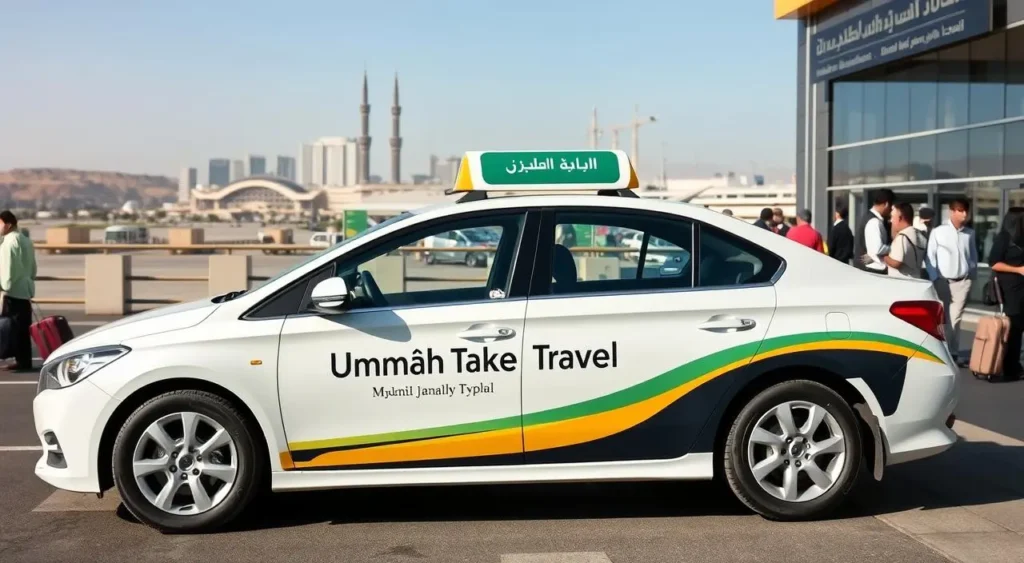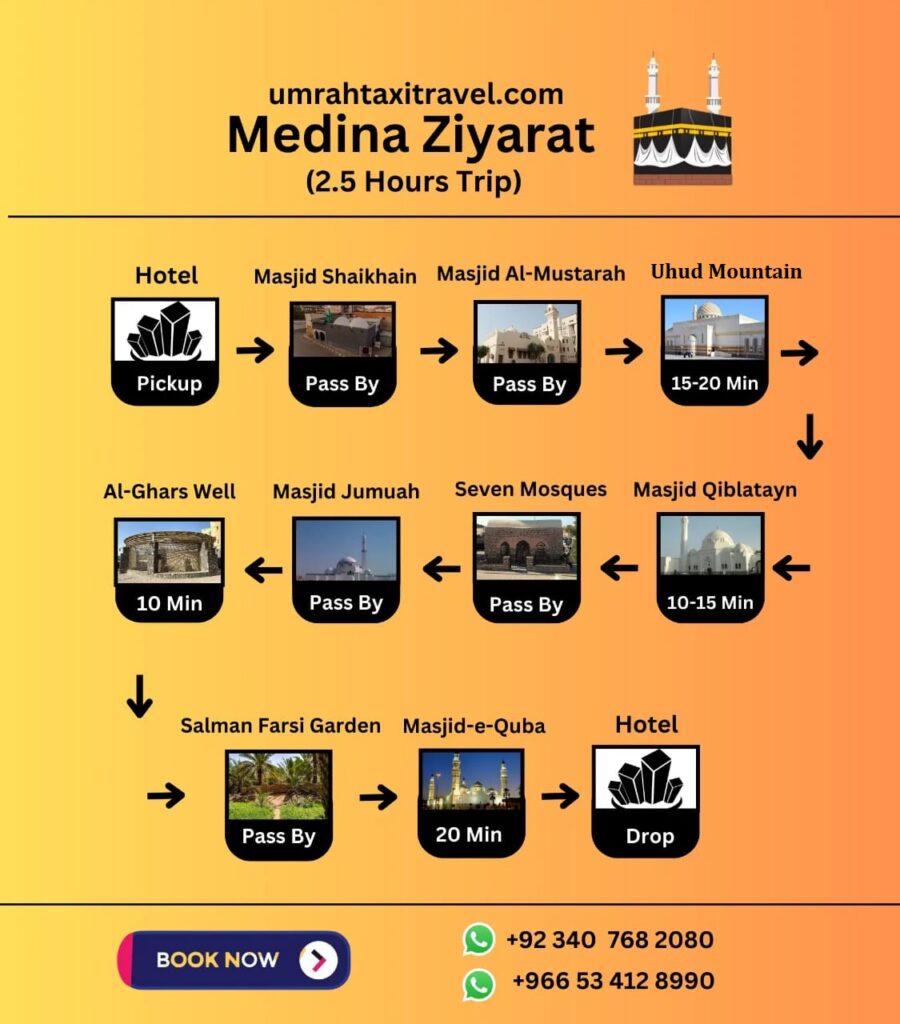Are you planning a ziyarat in Medina and need a reliable taxi? You have come to the right place! In this blog post, we will introduce you to the best taxi services options for Madinah ziyarat and give you tips on booking, pricing and ensuring a comfortable journey. We will make your spiritual journey hassle-free and comfortable!

Table of Contents
ToggleMadinah ziyarat Taxi Fare
The Madinah ziyarat taxi fare can vary based on several factors, including the time of day, the type of taxi, and the specific route taken. Here are some approximate estimates:
Camry Car (4 Seats & 3 Luggage): SAR 200
Hyundai H1 (7 Seats & 8 Luggage): SAR 250
GMC XL 2019 (7 Seats & 8 Luggage): SAR 300
GMC XL 2023 (7 Seats & 8 Luggage): SAR 350
Hiace (11 Seats & 15 Luggage): SAR 300
Coaster (21 Seats & 25 Luggage): SAR 400

Madinah ziyarat Places | Medina Holy Places
Oudh Medan:-
Historical Background: Located at the foot of Mount Uhud, Uhud Martyrs Cemetery is where 85 martyred soldiers from the Battle of Uhud are buried; the most notable would be the Prophet’s uncle, Hamza ibn Abdul Muttalib. Oudh Medan is a significant historical site in Medina. It is associated with various events from the early Islamic period and holds a special place in the hearts of Muslims. The exact historical events linked to this site may vary, but its significance as a place of gathering and prayer remains undisputed.
Significance: Oudh Medan is famous for its tranquil environment and spiritual atmosphere. This is where pilgrims and visitors come to meditate, pray and connect with the historical roots of Islam. The site is also noteworthy for its cultural significance, as it has been part of the medina’s heritage for centuries.
Visitor Information
- Location: Central Medina.
- Accessibility: Easily reachable by local transport.
- Visiting Hours: Open throughout the day.
- Etiquette: Maintain respect and reverence for this historical site.
Usman Ghani Garden:-
In the times of our Prophet (ﷺ), there used to be sweet water well in the city of Madinah and our Prophet (ﷺ) used to like its water. It was known as ‘Bir Roma’ i.e. Well of Roma.
The mentioned well was the property of a jew at that time, who used to sell water at a considerably high price and the poor inhabitants of Madinah were bound to pay such high to get water for their needs. Our Prophet (ﷺ) announced the glad tidings for the person who would buy the well and endow it for the people of Madinah.
Historical Background: Usman Ghani Garden, named after the third Caliph of Islam, Usman ibn Affan (RA), is a beautiful and historically significant garden in Medina. It is believed that Usman ibn Affan (RA) owned this garden and used its produce to support the Muslim community.
Significance: The garden is a symbol of Usman ibn Affan’s (RA) generosity and commitment to the welfare of the Muslim Ummah (community). It serves as a reminder of the early Islamic community’s values of charity, support, and communal well-being.
Visitor Guidelines
- Location:
- Accessibility: Open to the public.
- Visiting Hours: Best visited during daylight hours.
- Etiquette: Respect the environment and maintain cleanliness.
Masjid Al Qiblatain: –
Masjid al-Qiblatain, located in Medina, Saudi Arabia, is a significant historical site in Islam. Its name, which translates to “Mosque of the Two Qiblas,” refers to a unique event in Islamic history. Originally, Muslims prayed facing Jerusalem, but during a prayer led by Prophet Muhammad (peace be upon him) in this mosque, a revelation came instructing the change of the Qibla (the direction of prayer) to the Kaaba in Mecca. The immediate shift during the prayer is a momentous event recorded in Islamic history.
Historical Background: Masjid Qiblatayn, or the Mosque of the Two Qiblas, keeps a unique place in Islamic history. It is the mosque where the Prophet Muhammad (PBUH) received the revelation to change the direction of the Qibla (the direction Muslims face during prayer) from Jerusalem to Mecca.
Significance: The mosque has two prayer niches (mihrab) symbolizing the two qiblahs. Visitors can see historical and architectural features commemorating this important event.
Visiting Tips: When visiting, it is important to dress humbly and show respect for the holiness of the site. The mosque is easily accessible and has ample amenities for devotees.
Seven Masjid:-
These mosques are located on the western side of the Mount Sela’ when part of the trench was dug by Muslims in the time of Prophet Muhammad to defend Medina, when the Quraish marched in with the tribes in the fifth year of Hijra (migration).
Historical Background: The Seven Mosques, or Sab’ah Masajid, refer to a group of small mosques located near the site of the Battle of the Trench (Ghazwat al-Khandaq). Each mosque is associated with significant events or figures from the battle, which was a pivotal moment in early Islamic history.
Significance: Visiting the Seven Mosques offers a sight into the early history of Islam and the challenges faced by the Muslim community.
Tips for Visiting: It is important to access these sites with honor and respect. The mosques are relatively small, so visiting during off-peak hours can enhance the experience.
Battle of Khandaq:-
The battle is named after “trench”, or khandaq, that was dug by Muslims in preparation for the battle. The word khandaq (خندق) is the Arabised form of the Persian word kandak (meaning “that which has been dug”). Salman the Persian advised Muhammad to dig a trench around the city.
Historical Background: Battlefield of the trench, also known as the Battle of Khandaq, was a significant moment in Islamic history when Muslims defended Medina from a tribal confederation. The trenches dug by the Muslims played an important role in their defense.
Significance: The site of the Battle of Trench is a powerful reminder of the strategic insight and resilience of Prophet Muhammad (peace and blessings be upon him) and his companions. This symbolizes the importance of preparation and unity in the face of adversity.
Tips for Visiting: Visitors should plan their visit during the cooler months and respect the historical significance of the site.
Mountain Oudh:-
Located in the north of Madinah, Saudi Arabia, Mount Uhud is 7.5 kilometres wide and 3,533 ft. (1,077 metres) high. Mount Uhud is the place where the second most important battle between the non-believers of Makkah and the Muslims (Muhajireen and Ansar) of Madinah took place. It was fought on 19th March, 625 CE (3 AH). The initial victory of the battle turned to defeat for the Muslims when some fighters left their positions after mistakenly believing that the battle was over.
Historical Background: Uhud Mountain Cave is the site of the famous Battle of Uhud, fought between the early Muslims and the Quraysh of Mecca in 625 CE. The battle is remembered for its lessons on faith, determination, and the consequences of disobedience. The mountain and the surrounding area keep great historical and spiritual significance.
Martyrs’ Cemetery: The cemetery at the base of Mount Uhud is where many of the battle’s martyrs, including the Prophet’s uncle Hamza, are buried. It is a place for deep meditation and prayer. This Place is also known as Cave of Uhud and Jabal E Uhud.
Visiting Advice: Visitors should be respectful and contemplative when visiting Mount Uhud and the Martyrs’ Cemetery. The area can be quite busy, so visiting early in the morning can provide a more peaceful experience. Dressing modestly and behaving appropriately are important.
Beer-e-gharas (Al-Ghars well):-
Bir Ghars (Arabic: بئر غرس) was one of the wells that was favoured by the Prophet ﷺ due to the freshness of its water. The Prophet ﷺ drank from the well, made Wudhu with its water and requested that he be washed using its water after his death.
Historical Background: Al-Ghars well is one of the wells associated with Prophet Muhammad (peace and blessings of Allah be upon him). It is believed that the Prophet drank from this Ghars well, making it a place of great spiritual significance(Beer E Ghars). The Well of Ghars is located in the Cuban Medina area.
Significance: meaning A visit to the Al-Ghars well provides a unique opportunity to experience the daily life and routine of the Prophet. This reminds us of the simplicity and humility of the early Islamic communities.
Visiting Tips: Visitors are advised to arrive early in the morning to avoid crowds. Modest dress and respectful behavior are required when visiting this and other sacred sites in the medina.
Salman Farsi Bagh(Garden of Hazrat Salman Farsi):-
The Garden of Salman Al Farsi (R.A.) is a historical site in Madinah. The garden has a unique significance in Islamic history. It was planted by the Holy Prophet (P.B.U.H.) and his companions to free Salman Al Farsi (R.A.) from the slavery of his Jewish master when the Muslims along with Holy Prophet (P.B.U.H.) migrated from Makkah to Madina.
Historical Context: The Garden of Hazrat Salman Farsi is named after Salman the Persian, a close companion of the Prophet Muhammad (PBUH). The garden is known for its historical significance and natural beauty.
Religious Significance: Salman Farsi’s contributions to the early Muslim community are commemorated in this Salman Al Farsi Garden. Visitors come to pay their respects and seek inspiration from his life and dedication to Islam.
Visitor Tips
- How to Get There: Accessible by local transport.
- What to Expect: A peaceful and reflective environment.
- Visiting Hours: Open to the public throughout the day.
Quba Mosque (Masjid E Quba):-
Quba Mosque, the first mosque in Islam, was built-up by Prophet Mohammed (peace be upon him) in 622 AD, the year when he migrated from Makkah to Yathrib, an event considered by Muslims the start of the Islamic calendar. Accordingly, it is over 14 centuries old!
Historical Background: Masjid Quba holds the distinction of being the first mosque ever built in Islam. The Prophet Muhammad (PBUH) laid its foundation shortly after his arrival in Medina. The mosque is located on the edge of Medina and is a proof to the early days of the Islam.
Significance: MASJID-E-QUBA is highly revered in Islamic tradition. It is mentioned in the Quran, and the Prophet Muhammad (PBUH) himself visited it frequently. Praying at Quba Mosque is considered especially virtuous, and pilgrims often visit it to seek blessings.
Visiting Details : The mosque is open to visitors throughout the day. It is advisable to visit during the cooler parts of the day, such as early morning or late afternoon. The mosque is well-maintained, and facilities for ablution (wudu) and prayer are readily available.
Masjid Jummah:-
First place where the beloved Prophet s.a.w.s. led Jummah.. Masjid Jummah – Located on the boundary of Madinah marks the site where the Prophet (peace and blessings of Allah be on him) led the first Jummah salah, shortly after his Hijrah (migration) from Makkah. It is about 2.5 km from Masjid-e-Nabwi.
Historical Background: Masjid Jummah is where the Prophet Muhammad (PBUH) led the first Friday prayer after his migration to Medina.
Significance in Islam: The mosque holds great historical and religious significance as the site of the first Juma prayer, an important weekly congregational prayer in Islam.
Tips for Visitors
Location: Near Quba Mosque.
- Accessibility: Easily reachable by local transport.
- Visiting Hours: Open throughout the day.
Masjid Bilal(Masjid Al Bilal):-
This mosque is historically and religiously important to Muslims because it is named after Hazrat Bilal (RA), the first Muazzin, which is someone who calls to daily prayers in Islam, and was renowned for his voice. He was a former slave and was one of the close companions of the Prophet (PBUH).
Historical Background: Masjid Al Bilal is named after Bilal ibn Rabah, the first muezzin (caller to prayer) in Islam and a close companion of the Prophet Muhammad (PBUH).
Significance in Islam: Bilal’s role as the first muezzin and his dedication to Islam are honored through this mosque. It stands as a tribute to his faith and service to the Muslim community.
Visiting Guidelines
Location: Near the Masjid al Nabawi.
- Access: Easily reachable by foot.
- Best Times to Visit: Open throughout the day for prayer and contemplation.
House of Sayyidah Fatima bint Hussain (RA):-
Fāṭima bt. al-Ḥusayn (Arabic: فاطمة بنت الحسین), was the eldest daughter of Imam al-Husayn (a) and her mother was Umm Ishaq.
Historical Significance: The house of Sayida Fatima bint Hussein (RA) is an important site associated with Fatima, the granddaughter of Prophet Muhammad (peace and blessings of Allah be upon him).
Religious Importance: The house is a place of respect for pilgrims who visit to honor Fatima’s legacy and reflect on her contributions to Islam.
Visitor Information:
- Location: Near the Masjid Nabawi.
- Accessibility: Easily reachable by foot or local transport.
- What to Expect: A serene and reflective environment.

Madinah ziyarat: Distance and Travel Time
The Madinah ziyarat tour includes normally 8-10 holy places and completes in 2 hours varying with traffic and road conditions.
Important Note: During peak hours and religious seasons like Hajj and Umrah, traffic can be quite heavy. It’s recommended to plan your journey with this in mind.
How to Book a Madinah ziyarat taxi
You can easily book a Madinah ziyarat taxi through Our Website Umrah Taxi Travel or by contacting directly via
Whastapp : +966 53 412 8990 or +92 340 768 2080
Don’t wait – contact us today and enjoy a stress-free journey from Makkah to Madinah!

Why you should Choose Umrah Taxi Travel?
Specialized Service: Umrah Taxi Online is tailored for Umrah pilgrims, covering key routes like Makkah to Madinah.
Competitive Fares: We provide competitive pricing to fit every budget.
Diverse Fleet: Select from a wide range of vehicles.
Easy Booking: Book your ride with just a few clicks.
Professional Drivers: Our experienced drivers ensure a smooth and informative journey.
24/7 Service: Enjoy hassle-free travel at any time.
Choose Umrah Taxi Online for a stress-free pilgrimage.

Booking Tips
- Off-Peak Travel: If your schedule allows, consider traveling during off-peak hours to avoid heavy traffic, potentially reducing both travel time and fare.
- Pre-booking your taxi can help you secure a fixed rate and avoid any potential price fluctuations.
- Before getting into the taxi, discuss the fare with the driver and ensure there are no misunderstandings later.

History of the Ziyarat in Madinah; Best places worth visiting while in Madinah
Madinah is certainly one of the cities that every pilgrim hopes to see, and undoubtedly, the performance of Ziyarat in Madinah is among the aims of the visit. In the quest of trying to comprehend the religious importance of a given place, a walk around key attractions as well as sites of historical interests draws one closer to Islamic culture. In this guide, we will take you through the major sites of Ziyarat in Madinah, the methods of moving within the municipality, and the expenses that would be incurred during your Ziyarat tour.
Top 5 Most Revered Ziyarat Places in Madinah
Here is a complete Madina Ziyarat List of significant places that each pilgrim ought to visit:
- Masjid Quba – The first mosque constructed by the Messenger, Muhammad sallallaahu alayhe wa sallam.
- Masjid al-Qiblatain – This is the mosque where the Masjid al-Aqsa was replaced with the Kaaba as the Qibla.
- Mount Uhud – Mount Ohud is significant to the history of the Uhud kahar battle, and widespread conflict.
- Jannat al-Baqi – The graveyard where many companions of the Prophet PBUH are laid to rest, is a well-known cultural site.
Madina Ziyarat Places List
So here’s a full Madinah Ziyarat List which can help to allow you in ensuring the none of the important sites are skipped.
- Masjid Quba
- Masjid al-Qiblatain
- Mount Uhud
- Jannat al-Baqi
- Masjid Ghamama
- Masjid Al-Nabawi
- Masjid Bilal
- Masjid Ali
- Badr Battleground
- Castle of Urwah bin Zubair
Ziyarat in Madinah: Roads and Taxis
The best way to travel around the city and go to these holy places is to hire a Madinah Ziyarat Taxi. We can cover all major sites in one tour as we have the right and comfortable transportation so that we do not have to worry about missing out any important places.
Ziyarat Places | Approx. Distance from Masjid Al Nabawi (km) | Taxi Fare (SAR) |
Masjid Quba | 6 km | 25-40 |
Masjid al-Qiblatain | 8 km | 30-45 |
Mount Uhud | 5 km | 20-35 |
Jannat al-Baqi | 1 km | 10-20 |
Masjid Ghamama | 2 km | 10-25 |
Praying at the shrines in Madina is a coveted achievement for many Muslims. Here’s how to go about it. Follow this simple guide to enhance your Ziyarat experience:
- Arrange in Advance: Familiarize yourself with the key Ziyarats in Madina and organize them according to regions.
- Taxi Services: To make movement in the city effortless, employ Madinah Ziyarat Taxi service.
- Early Visits: To see the sights without large crowds, make your day start early in the morning as there will be so many people at main places like Masjid Quba.
- Observe Appropriate Behavior: Dress and act appropriately, while observing the dos and don’ts as per the local customs and cultures in all the religious places.
Taxi Services For Ziyarat in Madinah
We provide Ziyarat triers taxi services Madina for coverage of all relevant sites. Our drivers drive through the holy places of the city in a respectful and responsible manner.
Service | Cost (SAR) | Remarks |
Taxi for Ziyarat (4 hours) | 200-300 | Covers major Ziyarat sites |
Full Day Ziyarat Tour | 400-500 | Includes private car and driver |
Shared Taxi for Ziyarat | 50-100 | Ideal for budget-conscious pilgrims |
Madina Ziyarat Cost
The cost of performing Ziyarat in Madina is subject to the mode of travel. Below is a breakdown of possible costs that one would incur when performing Ziyarat.
- Taxi Fare: Generally range from a site to another site between SAR 10 to SAR 50 exclusive of the distance from Masjid Al Nabawi.
- Private Ziyarat Tour: In this case, a person goes out for an entire day and incurs a cost between SAR 300 t0 SAR 500 in order to have a dedicated tour.
Is it Necessary to Visit Madinah During Umrah?
It is not a must to go to Madinah for Ziyarat during Umrah, however it is something that is highly encouraged. Many visits Al Madinah and take this chance to appreciate the importance of such a holy city to the Muslims. Going in the Ziyarat places in Madinah has a better understanding of the past in the perspective of Islam and Muslims as taught by the Prophet Muhammad (PBUH).
Ziyarat in Madinah PDF Guide
In your travel we also have an easier option which is a Ziyarat in Madina PDF Guide that can be downloaded. This contains images, important historical information, and recommendations on how to properly carry out Ziyarat in Madina.
Madina Ziyarat Guide
If you require any further clarification, consult the guide madina ziyarat guide in Urdu PDF available, for more descriptions regarding each of the sites, places, and their respective purposes.
FAQs
- What is Ziyarat in Madina?
Ziyarat is the act of going to places of interest in Madinah that have important connections to Islamic sites and to the Prophet Muhammad (PBUH) himself.
- How many Ziyarat are in Madina?
There are also a number of other Ziyarat including some other important ones like Masjid Quba, Mount Uhud and Jannat al-Baqi. Our guide outlines at least ten such locations.
- Is it mandatory to go to Madinah after Umrah?
Not compulsory, but it’s strongly advised to travel to Madinah because of the high spirituality this place carries.
- What is the range of a Madinah Ziyarat taxi?
Taxi rates for law Ziyarat in Madinah can also be between SAR 10 to 50 for each site depending on the distance.
5.Where can I locate a Ziyarat guide of Madina?
For a more complete assistance about Ziyarat’s places, you may download the Ziyarat Madina PDF file through this site.
Conclusion:
Summing up, taking a Ziyarat in Madinah is a profound and diverse spiritual journey that Jupiter Transit has provided to all righteous people. Irrespective of that whether you go to the main Ziyarat destinations or drive for a complete Ziyarat tour, we guarantee the best comfortable taxi services throughout your journey. May your stay in the Holy city of Madinah be blessed with peace and fulfillment of your spiritual needs.

